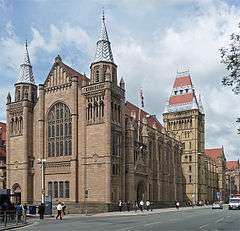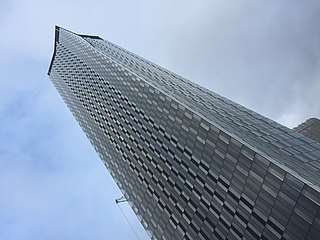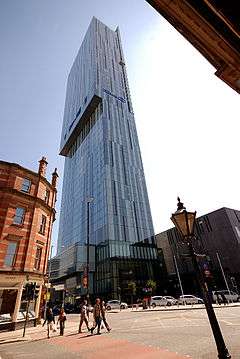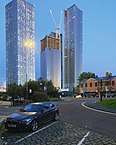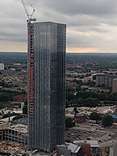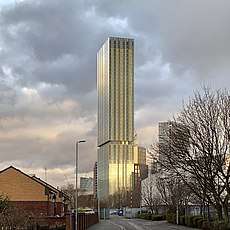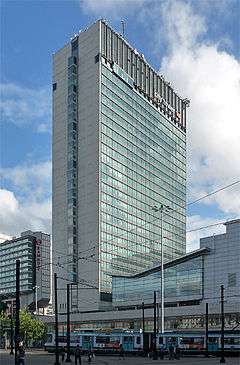Manchester Aquatics Centre
The Manchester Aquatics Centre, abbreviated MAC, is a public aquatics sports facility south of the city centre of Manchester, England, north of the main buildings of the University of Manchester near Manchester Metropolitan University. It was purpose built for the 2002 Commonwealth Games,[1] and cost £32 million to build.[2]
| MAC | ||||||||||||||||||||||||||
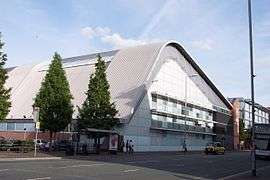 | ||||||||||||||||||||||||||
| Building information | ||||||||||||||||||||||||||
|---|---|---|---|---|---|---|---|---|---|---|---|---|---|---|---|---|---|---|---|---|---|---|---|---|---|---|
| Full name | Manchester Aquatics Centre | |||||||||||||||||||||||||
| City | Manchester, England | |||||||||||||||||||||||||
| Capacity | approx. 1000 | |||||||||||||||||||||||||
| Built | 1996–2000 | |||||||||||||||||||||||||
| Opened | 12 October 2000 | |||||||||||||||||||||||||
| Architect(s) | FaulknerBrowns Architects | |||||||||||||||||||||||||
| Home club(s) |
| |||||||||||||||||||||||||
| Pools | ||||||||||||||||||||||||||
| ||||||||||||||||||||||||||
Before it was built, for many years its site was open waste ground, left by demolishing inner city industrial terrace houses. The building was designed by FaulknerBrowns Architects. The building takes the approximate shape of an asymmetric trapezoidal prism (the apex provides clearance above the highest diving board), and from the outside, the roof resembles a wave.
Construction started in August 1996, and was completed in July 2000,[3] with finishing touches made in September 2001. MAC hosts many swimming and water polo events but also hosts Lancashire County Championships and Age group North west Regionals for swimming.[4] It was opened on 12 October 2000, by Queen Elizabeth II.[5]
Facilities
The centre's facilities include:
- Two 50 m swimming pools,[1] each able to be split into sections of varying dimensions and depths with the help of moveable floors and booms. In fact, the centre has the world's largest area of movable floors and booms in a swimming facility.[3]
- The "main pool" on the ground floor is 50 m by 20 m with a maximum depth of 2 m. A sinkable boom can separate the pool into a 23 m by 21 m with constant depth between floor level and 2 m depth; and a 25 m by 21 m section at 2 m depth, which in turn can be separated by another sinkable boom to allow a section of 10 m by 21 m. The floors of these 3 sections can each be independently raised or lowered between very shallow and 2 metres (6 feet 7 inches) depth. 1,000 permanent spectator seats overlook the main pool hall.
- The "training pool" is located in the basement and is 16 m by 50 m in size, with a constant depth of 1.8 m. A traversable boom allows separation into two 25 m length pools, one of which can be varied in depth from floor level to 1.8 m. The training pool's ceiling is in the shape of two long waves representing waves on water.
- A 25 m diving pool (ground level) with movable floor to allow a maximum depth of 5.1 m. The pool is often also used for water polo,[6] and scuba diving training.
- A "leisure pool" (ground floor) – a shallow water area suitable for younger pool users, with two water flumes and two bubble pools.
- Workout and fitness studios (behind the spectator seating), a health suite including sauna and steam room.[7]
- Poolside cafe.
Use
It is jointly owned by Manchester City Council, the University of Manchester and Manchester Metropolitan University.[4] All the facilities can be used by members of the public.
The centre is the home of the City of Manchester Aquatics Swim Team,[8] as well as Disability Swimming and Water Polo athletes within the English Institute of Sport.[9]
As well as the 2002 Commonwealth Games, the MAC has been used for:
- Paralympic World Cup since 2005
- Training for 9th FINA World Short Course Championships 2008
- Duel in the Pool 2009
- LEN European Waterpolo
- Training for teams for the 2012 Olympic Games
- SwimBritain 2013
See also
References
- "Manchester Aquatics Centre". Manchester City Council. Archived from the original on 2008-03-11. Retrieved 2008-03-19.
- "BBC Sport - Commonwealth Games 2002 - Venue Guide - Manchester Aquatics Centre". BBC Sport. Retrieved 2008-03-19.
- "Manchester Aquatics Centre - Europe and the Middle East - Arup". Archived from the original on 2007-02-22. Retrieved 2008-03-19.
- "Manchester Aquatics Centre Prepares for 2002". SportBusiness.com. 27 September 2001. Retrieved 2008-03-19.
- Bremner, Charles; Robertson, David (13 October 2000). "Court circular". London: The Times. Archived from the original on 5 May 2013. Retrieved 2008-03-19.
- "Paralympic World Cup - Manchester Aquatics Centre". Retrieved 2008-03-19.
- "Manchester Aquatics Centre". University of Manchester. Archived from the original on 2007-07-23. Retrieved 2008-03-19.
- "City of Manchester Aquatics Swim Team". Archived from the original on 2007-10-13. Retrieved 2008-03-19.
- "The Manchester Aquatics Centre". English Institute of Sport. Archived from the original on 2008-04-11. Retrieved 2008-03-19.


